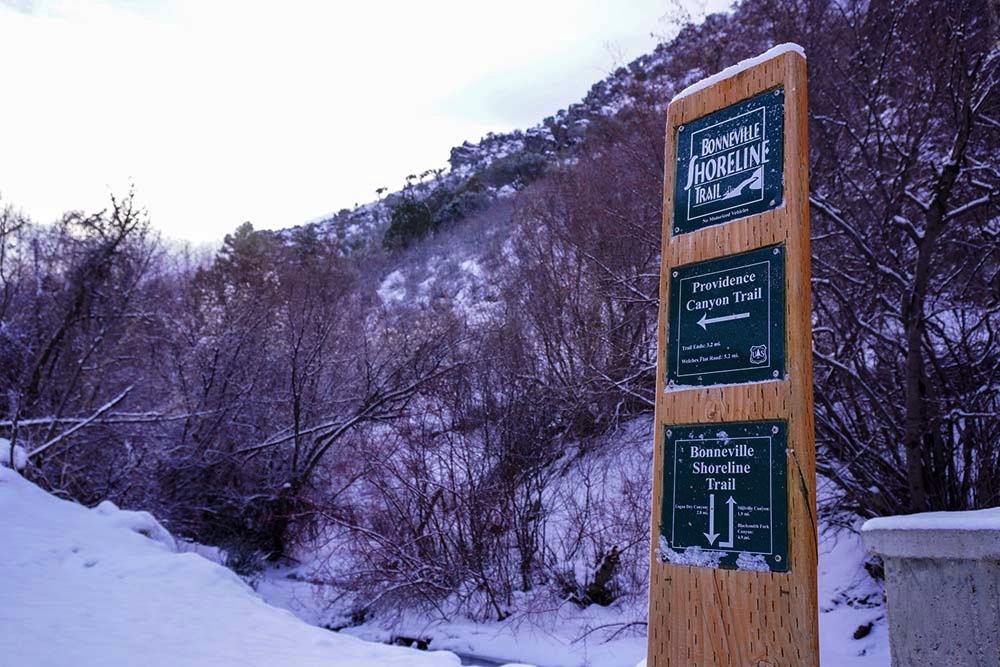Trail etiquette implemented at popular Logan trailheads
Starting in spring, Logan’s most popular mountain biking trailheads, Green Canyon and Providence Canyon, will have trail etiquette signage and passive bells at the mouth of the canyons.
In an effort to increase trail safety, Cache Trails Alliance, Cache County Trails Cache and the Bear River Health Department have organized this effort.
The passive bells—bells that do not need to be struck—are intended to be used when biking the trail and should be returned to the kiosk.
Trail usage has seen a significant increase since the start of the pandemic.
Through observation, CTA, the Trails Cache, and BRHD have determined a need for public education on trail etiquette and safety.
Carly Lansche, regional trail and active transportation coordinator for Cache County, has been leading this campaign. Other representatives include Natalie Tippets, a health educator for BRHD and Alyson Ward, community partnerships director for CTA.
“We are trying to encourage good behavior and etiquette across all trail users, no matter if you’re a biker, a hiker, or if you’re on horseback,” Lansche said. “Primarily we want to reinforce the idea that in typical trail etiquette, the uphill climbing traffic should have the right of way. Others should yield to them.”
Ward has seen increased user conflict with the rise of trail usage and hopes this campaign aids in kindness and safety on the trails.
Expansion of the campaign to other trail heads will be determined from feedback after the upcoming trail season.
Britton Parkinson, a Utah State University student, said he’s seen an increase in trail usage and a lack of trail etiquette.
He supported the new signage, as he has seen it be successful around the state in places such as Draper, Eagle Mountain, Park City, St. George and Moab.
Parkinson hasn’t seen passive bells provided elsewhere, but said they are a good idea to have.
He said most trail users already follow proper etiquette, but it never hurts to have trail etiquette education.
“I really think the valley does well with its trail etiquette, but there is always room for improvement,” Parkinson said. “Trusting in other trail users is essential and our safety, our family’s safety, and our furry friends’ safety all weigh on each individual’s cooperation with the trail etiquette that has been set in place.”
Trails Cache and CTA encourage trail users or those who are interested to attend the Adopt-A-Trail kickoff event in April. This event will include information about the bell campaign and volunteering needs.
“We have so many great trails close to us here in Cache Valley,” Tippets said. “As the weather warms up, I would encourage everyone to get out and try a trail.”
Trails Cache and CTA events and information can be found on social media @trailscache or on their website. If interested in volunteering, email trails@cachecounty.org.
-Maya.Mackinnon@usu.edu
Featured photo by: Phil Weber


Trail etiquette education on these two trails is a fine. Along with any signage for that purpose, I would suggest reminders to be patient with ALL riders, including perhaps most especially novices, who aren’t always readily identifiable in brief trail encounter. The article mentioned an observed rise in conflict. I have also observed this. On one particular occasion I observed on Providence Trail, a rider who appeared in all ways to be experienced and acquainted with proper etiquette was going uphill and so had the right-of-way. One might say he need not move to the side or make ANY effort to provide space for a rider coming downhill. Indeed this is exactly what he did although he easily could have. Much easier than the downhill rider could have. The downhill rider naturally was moving faster and thus any accommodation he would make for the rider coming uphill would require a faster response. Indeed it appeared that he was attempting to respond but didn’t fully get out of the way in time and they’re handlebars clipped. Both stayed upright and so the outcome was a minor incident. Yet, this infuriated the uphill rider who was likely aware of his rights according to standard etiquette, but apparently not ware at all of common courtesy which in my belief includes giving others the benefit of the doubt and of offering grace. The downhill rider apologized as the uphill rider continued to berate him. I observed the trail at this portion to be one that left a downhill rider, if he is anything less than expert with little choice for altering his path and speed. This is especially true given he was clipped into pedals. Perhaps they didn’t release as intended. It could be a lot of different reasons. I understand the logic of designating the uphill rider as the one with right-of-way. But sometimes, with all the best intentions, it may not work out. Everyone should aim to be friendly and forgiving on the trails! Indeed, I observe the vast majority are.